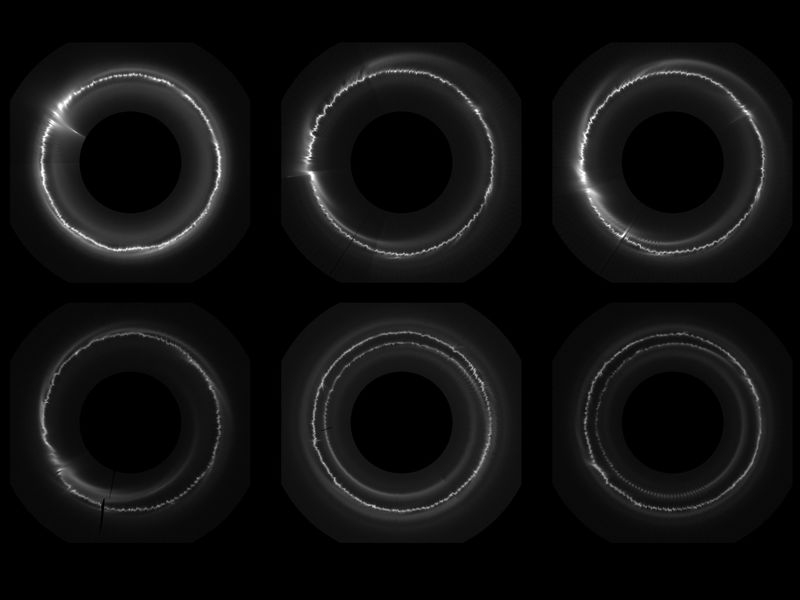The objects, termed ‘mini-jets’, were found by scientists from Queen Mary University of London as they were working with images from NASA’s Cassini Spacecraft. They fill a missing hole in our understanding of the curious behaviour of the F ring. The results are being presented at the European Geosciences Union meeting in Vienna (24 April 2012).
“These latest Cassini results go to show how the F ring is even more dynamic than we ever thought,” said Carl Murray, a Cassini imaging team member based at
Queen Mary University of London (link opens in a new window). “These findings show us that the F ring region is like a bustling zoo of objects from a half mile in size to moons like Prometheus a hundred miles in size, creating a spectacular show.”
Scientists have known that relatively large objects like the moon Prometheus (as long as 92 miles across) can create channels, ripples and snowballs in the F ring. But until recently they did not know what happened to these snowballs after they were created.

Wiggly F ring
(Credit: NASA/JPL-Caltech/SSI/QMUL)
Now a team from Queen Mary’s Astronomy Unit have found evidence that some of the smaller snowballs survive, and their differing orbits mean they go on to strike through the F ring on their own.
Professor Murray’s group happened to see a tiny trail in an image from 30 January 2009 and tracked it over eight hours. The long footage confirmed the small object originated in the F ring, so they went back through the Cassini image catalogue to see if the phenomenon was frequent.
“The F ring has a circumference of 550,000 miles (881,000 kilometres) and these mini-jets are so tiny they took quite a bit of time and serendipity to find,” said Nick Attree, a Cassini imaging associate at Queen Mary. “We combed through 20,000 images and were delighted to find 500 examples of these rogues during just the seven years Cassini has been at Saturn.”
Full details can be found in press releases from both NASA (link opens in a new window) and
Queen Mary University of London. (link opens in a new window)STFC’s RAL Space worked with the Open University on the build of the Surface Science Package on the Huygens probe that landed on Saturn’s moon Titan in 2005 as part of the Cassini-Huygens mission, to make the first analysis of the surface of Titan. RAL Space also contributed hardware for the Cassini Plasma Spectrometer (CAPS) instrument and the Cosmic Dust Analyser (CDA) instrument on Cassini and Malcolm Dunlop from RAL Space is involved in the science team. STFC is the UK sponsor of astronomy.
The UK Space Agency (link opens in a new window) represents the UK interests in Cassini Huygens at the European Space Agency which coordinates this mission along side NASA and the Italian Space Agency. The UK Space Agency is at the heart of UK efforts to explore and benefit from space within our solar system, as with this latest Cassini discovery, and beyond. It is responsible for all strategic decisions on the UK civil space programme and provides a clear, single voice for UK space ambitions.
The six UK institutions involved with analysing data from Cassini are:
• University of Oxford (link opens in a new window)
• Queen Mary University of London (link opens in a new window)
• University College London (link opens in a new window)
• Imperial College London (link opens in a new window)
• Open University (link opens in a new window)
• University of Leicester (link opens in a new window)
Cassini’s profile continues to rise as one of the Principal Investigators, Michele Dougherty, has been elected a Fellow of the Royal Society (19th April). This excerpt is from the Royal Society’s website:
‘Distinguished for her scientific leadership of the international NASA-ESA-ASI Cassini-Huygens mission to Saturn and its moons. As Principal Investigator of the operation, data collection and analysis of observations from the magnetic field instrument onboard the Cassini spacecraft she was responsible for major advances in our understanding of the physics of the Saturn system’.
Michele Dougherty’s profile and more information can be found on the
Royal Society (link opens in a new window) website.
For more information please contact:
RAL Space Enquiries
